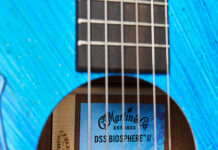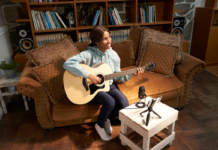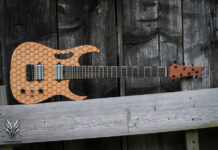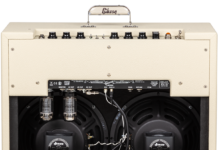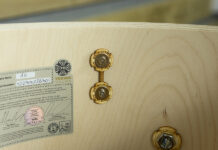
Three Scary, Rut-Busting Licks Inspired by George Lynch
I’m talking about the unmistakable signature graphics on the guitars of “Mr. Scary,” A.K.A. George Lynch. But the graphics are not nearly as recognizable as Lynch’s frighteningly unique phrasing, tone and vibrato. Since the early 1980s, soulful shred Sensei George Lynch has challenged the boundaries of his abilities, constantly evolved with the times and kept his playing fresh.
Since the early Eighties, soulful shred sensei Lynch—”Mr. Scary”—has challenged the boundaries of his abilities, constantly evolved with the times and kept his playing fresh.
While Lynch’s adventurous style is difficult to emulate, bust out of a rut and get some harmonically fresh and physically engaging “Scary”-ness in your playing with these “Mr. Scary”-inspired licks.
SCARY LICK 1 is an E diminished 7 (E, G, Bb, Db) symmetrical string skipping tap pattern on the G and high E strings. The diminished7 arpeggio pattern (R, b3, b5, bb7) can be visualized on the guitar as notes occurring every three frets from the root on the same string (For example, an open E string root would use the 3rd, 6th, 9th, 12th, 15th, 18th and 21st frets in a repeating single string E dim7 arpeggio).
Since G is a note in E dim7, and G and E are both open strings, symmetrical fretting works across both strings and all the way up the fretboard. The pattern in the lick on both the E and G strings is frets 9, 12, 15, 18, 21 (on the high E). Tap the 18th fret with your pick hand middle finger and fret the 9th-12th-15th stretch with index-middle-pinky, respectively (the 21st fret is slid into with a slide of the tapping finger with the note still ringing after the initial tap at the 18th).
SCARY LICK 1A is the lick in 4/4 time with an “accelerator” shift to sextuplets from sixteenths (6s from 4s) on beat 3. SCARY LICK 1B is the pattern looped evenly in ¾ time (also try looping it indefinitely over 4/4 time for a trippy off-center effect). Check out how this lick grabs your attention yet blends seamlessly in an E Dorian/blues context (as it has the E and G from Em, the Db/C# from E Dorian, and the Bb from E blues).
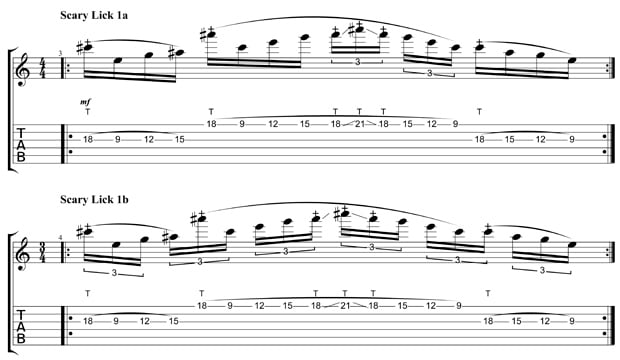
SCARY LICK 2A features a major triad shape ascending diagonally up the fretboard a tritone (aka “The Devil’s Interval,” and the Diabolus in Musica) at a time. Kirk Hammett famously “borrowed” a lick similar to this Lynch lick on a certain …And Justice For All track. Lynch’s version can be heard in his searing “Kiss of Death” solo (Back for the Attack, Dokken).
Notice the fingering in the notation and move the triad shapes up a string and position at a time using economy picking. SCARY LICK 2B is a sequence with the shapes using a “1-2-3, 2-3-4, 3-4-5” type pattern.

SCARY LICK 3 uses Lynch’s infamous “Gothic Octave” shape (illustrated in the lick as the 4th, 5th and 9th frets on the E and A strings, played across 3 octaves), with tapped notes a fret higher than the pinky notes in the shape. There are a lot of “cluster” notes interacting inside of this lick, yet the clusters are spread out intervalically, so there’s also a lot of attention-grabbing movement in it.
This lick will work (in different ways) when played quickly and with conviction in F#m/A major, C#m/E major and G#m/B Major. Try ending it with some more tap sliding to the “money” notes in the key that you’re trying to fit it in.

Practice these licks until you’re comfortable with performing them at a brisk pace, and then try channeling the spirit of Mr. Scary by using these licks as a springboard for further experimentation in and around them.
Dial in a deadly tone, get fiery with your phrasing, and rock a vicious vibrato. Be sure to check out Dokken’s Beast From the East live greatest-hits CD, Lynch Mob’s Wicked Sensation and George Lynch’s solo covers album Furious George for some killer guitar work that’s sure to inspire any guitarist. Happy shredding!
Scott Marano has dedicated his life to the study of the guitar, honing his chops at the Berklee College of Music under the tutelage of Jon Finn and Joe Stump and working as an accomplished guitarist, performer, songwriter and in-demand instructor. In 2007, Scott developed the Guitar Strength program to inspire and provide accelerated education to guitarists of all ages and in all styles through state-of-the-art private guitar lessons in his home state of Rhode Island and globally via Skype. Visit Scott and learn more at www.GuitarStrength.com.
Source: www.guitarworld.com


